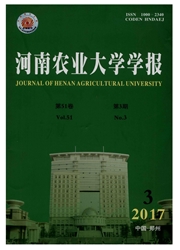

 中文摘要:
中文摘要:
在室内(25±1)℃,详细观察了小菜蛾两种幼虫内寄生蜂的胚胎发育过程.其中,菜蛾盘绒茧蜂胚胎发育经历大约48h.根据胚胎发育的先后顺序可将其划分为以下3个时期:卵裂与胚盘形成期,即产卵后20h时,在卵周缘形成均匀的单细胞层;原肠胚形成及器官发育期,产卵后20~32h,包括胚带形成、原头原躯分化、1:7道形成及消化道发育;最后是胚胎背合与胚胎成熟期,在产卵后48h,胚胎发育完成,并在蜂卵孵化时,源自浆膜的畸形细胞释放到寄主小菜蛾的血腔中.相同培养条件下,半闭弯尾姬蜂的胚胎发育历经50h.根据胚胎的形态特征将胚胎发育过程同样划分为3个阶段:分别是产卵后12h的卵裂与胚盘形成阶段、产卵后12~32h的原肠胚形成和器官发育阶段、以及随后的胚胎背合和胚胎成熟阶段,即产卵后32~50h,直至姬蜂卵孵化.与茧蜂不同的是,姬蜂卵孵化时,浆膜并不产生释放畸形细胞.
 英文摘要:
英文摘要:
The embryonic development of two larval endoparasitoids of Plutella xylostella was observed by dissecting parasitized hosts in the laboratory at (25 ± 1 ) ℃. The development period required for Cotesia vestalis embryo was about 48 h. It passed through mainly three rather different stages according to their developmental succession. The first stage included the cleavage and blastoderm stages, and cleavage ended with the formation of a blastula after 20 h oviposition. The second phase was called gastrulation and organic development stages from 20 to 32 h after oviposition, including germ band formation, germ band expanding, differentiation of protocorn and protocephalon, formation of the alimentary canal and mouthparts, and organic formation. The last phase included the dorsal closure and embryo maturation stages from 32 to 48 h after oviposition. Obviously, a lot of teratocytes originating from the serosal membrane were released into the host larval haemocoel. Under the same condition, the development of the embryo of Diadegma semiclausum was about 50 h. The process of the embryonic development was also divided into three stages on the basis of the characterization of embryo morphology. Just like C. vestalis, after 12 h oviposition, a blastula was formed. And then the gastrulation and organic development stages started from 12 to 32 h after oviposition. In the end, accompanied with the dorsal closure, the embryo began to mature. Fifty hours later, the first larva of D. semiclausum was hatched, but very different from C. vestalis, its serosal membrane could not produce tetatocytes at all.
 同期刊论文项目
同期刊论文项目
 同项目期刊论文
同项目期刊论文
 期刊信息
期刊信息
